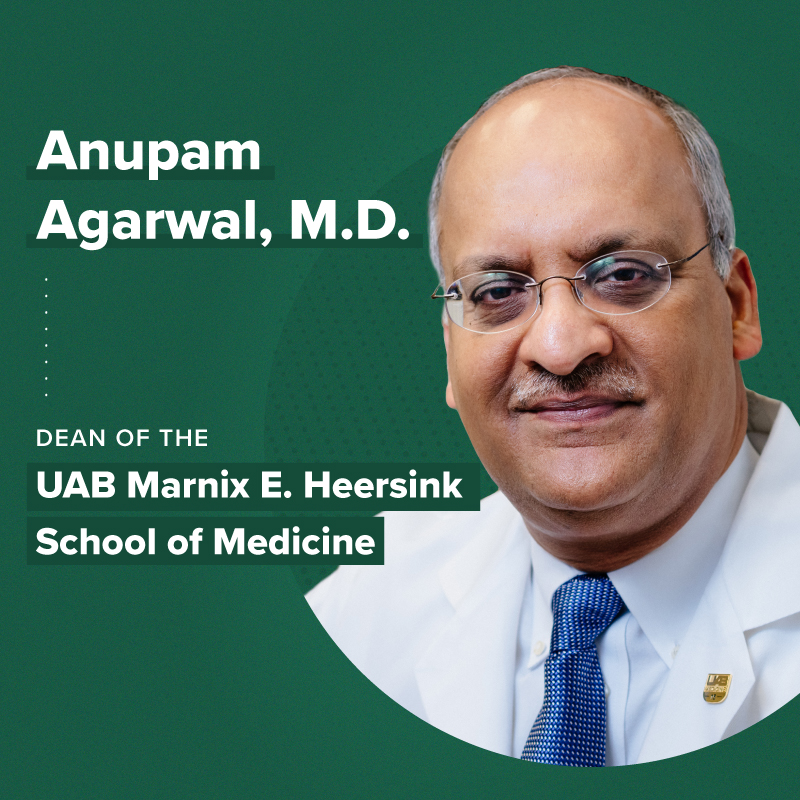This is the first of a three-part series introducing readers to the newly appointed senior vice president for Medicine and dean of the UAB Heersink School of Medicine, Anupam Agarwal, M.D. For this installment, we talked with Agarwal to learn more about his personal background and his path to medicine. Look for future installments—where we’ll learn more about Agarwal’s medical training and plans and vision for the Heersink School of Medicine—in the coming weeks.
 Becoming dean and senior vice president for Medicine of the UAB Marnix E. Heersink School of Medicine is a high-water mark in the life of Anupam Agarwal, M.D. He is the product of an eclectic life’s journey, one that was guided by a wide array of influences and interests.
Becoming dean and senior vice president for Medicine of the UAB Marnix E. Heersink School of Medicine is a high-water mark in the life of Anupam Agarwal, M.D. He is the product of an eclectic life’s journey, one that was guided by a wide array of influences and interests.
His parents hailed from Uttar Pradesh in northern India. His father graduated from the King George Medical College in the city of Lucknow and moved to southern India in 1959 so he could teach pathology at Kasturba Medical College at Mangalore University, a new medical college that had opened in the coastal town of Mangalore. “In those days it took almost three days by train to get to Mangalore from their hometown in the north—there were planes but not everyone could afford that.”
He says his parents’ greatest gift to their three sons was education. “When I was young, my parents never wasted a moment in highlighting the value of great education and pushed us hard to make use of the best possible opportunities at school.”
Early Interests
His early education at St. Aloysius School, a Jesuit-run Catholic school in Mangalore, brought him into contact with classmates from a broad range of backgrounds and beliefs, some of whom he still calls friends. “My town was about 15 percent Catholic—the Portuguese and Italians who came in the 1400s to the coastal regions of southern India to spread Christianity settled there—and it has amazing diversity. There were about 60 students in my class, and we had Muslims, Hindus, Catholics. To this day I have a WhatsApp group of my former classmates, who remain highly engaged and active as a closely knit group of friends.”
Many of Agarwal’s overriding interests and passions began while he was a student at St. Aloysius. He became an avid cricket player and played ping-pong and basketball (“I was short so I was a good three-point shooter”). He also learned to play the Indian classical violin—in part inspired by his mother’s love of music—which contributed to his lifelong appreciation for classical music. He also learned to speak four languages—three Indian languages, Hindi, Kannada, and Tulu, as well as English.
Not surprisingly, Agarwal showed an early aptitude for science. When he was in eighth grade, he won a statewide science fair. His project was an “Automatic Pooja (Prayer) Machine” that featured a statue of the Hindu god Shiva. Upon cutting a ribbon, the machine would automatically initiate a prayer with a flame igniting, a bell ringing, and a spray of water from the god Shiva’s head. The prayer would end when a coin was inserted into a slot machine and a religious offering of a sweet was dispensed. “I still have the winner’s certificate from 1976,” he says.
Because his father was a pathology professor, Agarwal was essentially raised at the medical college. “We lived in campus housing growing up and my dad was the warden for the medical students’ residence hall. So I grew up hanging around medical students, even though they were much older than me.”
Given his upbringing, it seems inevitable that Agarwal would develop an interest in medicine, but he cites a specific event as the turning point that cemented his desire to become a physician. “My dad brought a specimen of a heart in a formalin-filled jar to my fourth-grade class. He explained to my class how the heart works and pumps blood, and I remember thinking, ‘Wow, I want to practice medicine.’ That was tremendous for me.”
Making it to Medical School
Throughout his time at St. Aloysius, Agarwal was a top student, involved in numerous extracurricular activities and earning top grades in his classes. But some fateful advice almost derailed his medical school dreams.
“In India, you have to take three languages in high school and the rule was if Sanskrit was one of them another had to be Hindi. But because I spoke Hindi at home, the head of the school said I should learn the state language, Kannada. So that’s what I did and when the state was compiling final class results, they thought I was doing something fishy by not enrolling in Hindi and withheld my results. So I had to go with my parents to the State Ministry of Education and explain what had happened. Finally they released my results of my 10th grade year and it turned out I was the top scoring kid in the school.”
Despite that hurdle, Agarwal graduated St. Aloysius at the top of his class and entered Kasturba Medical College at Mangalore University in 1980 after completing a two-year pre-university college (equivalent to 11th and 12th grade).
Look for the next installment in this series to read more about Agarwal’s medical training and influential mentors.